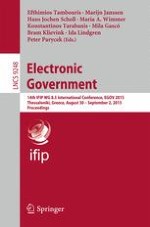2015 | Buch
Electronic Government
14th IFIP WG 8.5 International Conference, EGOV 2015, Thessaloniki, Greece, August 30 -- September 2, 2015, Proceedings
herausgegeben von: Efthimios Tambouris, Marijn Janssen, Hans Jochen Scholl, Maria A. Wimmer, Konstantinos Tarabanis, Mila Gascó, Bram Klievink, Ida Lindgren, Peter Parycek
Verlag: Springer International Publishing
Buchreihe : Lecture Notes in Computer Science
